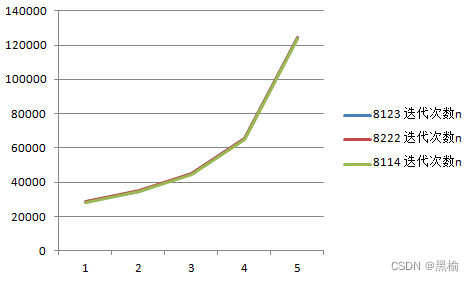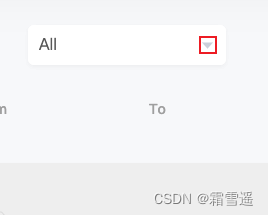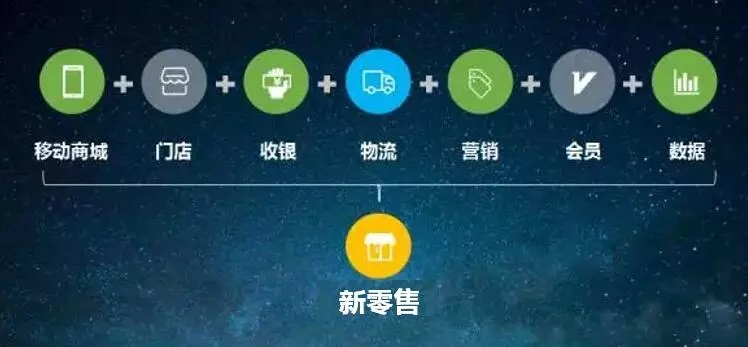当前位置:网站首页>Asynchronous programming solution Generator generator function, iterator iterator, async/await, Promise
Asynchronous programming solution Generator generator function, iterator iterator, async/await, Promise
2022-08-04 02:36:00 【rananie】
文章目录
异步编程解决方案 Generator生成器函数、iterator迭代器、async/await、Promise
Generator生成器函数
面试题
- generator用来做什么, generator函数的使用场景
- 介绍下es6 generator函数
- generator 实现 async await
Generator生成器函数
语法:function * 函数名(){}
是什么
Generator 函数是 ES6 提供的一种异步编程解决方案.Internally it can be seen as a state machine,返回迭代器对象,调用next方法进入下一个状态.yieldA flag to pause while expression
使用的场景
- Generator 函数会返回一个迭代器对象,因此可以把 Generator 赋值给对象的
Symbol.iterator属性,从而使得该对象具有 Iterator 接口. - async/awaitIt has its own actuatorGenerator对象
GeneratorComplementary to the use of generator functions 了解
generator函数可以用next方法来传参,该参数就会被当作上一个yield表达式的返回值.yield表达式本身没有返回值,返回undefined
所以第一次next传参是没用的,只有从第二次开始next传参才有用GeneratorGenerator function if there is a return value is the last timenext的返回值
{value:xxx:done:true}
function* gen() {
yield 1
yield 2
yield 3
}
const g = gen()
console.log(g.next()) // { value: 1, done: false }
console.log(g.next()) // { value: 2, done: false }
console.log(g.next()) // { value: 3, done: false }
console.log(g.next()) // { value: undefined, done: true }
// 有return值
function* gen() {
yield 1
yield 2
yield 3
return 4
}
const g = gen()
console.log(g.next()) // { value: 1, done: false }
console.log(g.next()) // { value: 2, done: false }
console.log(g.next()) // { value: 3, done: false }
console.log(g.next()) // { value: 4, done: true }
yield后面跟promise,函数立即执行
function f1(val){
return Promise.resolve(val);
}
function f2(val){
return new Promise(resolve=>{
setTimeout(()=>{
resolve(val)},1000);
})
}
function* gen() {
yield f1(1);
yield f2(2);
return 'ending';
}
const g = gen()
console.log(g.next()) // { value: Promise { 1 }, done: false }
console.log(g.next()) // { value: Promise { <pending> }, done: false }
console.log(g.next()) // { value: 3, done: true }
基于Promise对象的简单自动执行器
function f1(val){
return Promise.resolve(val);
}
function f2(val){
return new Promise(resolve=>{
setTimeout(()=>{
resolve(val)},1000);
})
}
function* gen() {
console.log(yield f1(1)); //1
console.log(yield f2(2)); //2
console.log(yield 'xxx');//'xxx'
return 'ending';
}
function run(gen){
var g = gen();
function next(data){
var result = g.next(data); //{ value: Promise { 1 }, done: false }
if (result.done) return result.value; //You can return after the execution is complete
Promise.resolve(result.value).then(function(data){
//获取promise的执行结果
console.log(data); //1,2,xxx
next(data); //将1作为yieId f1()执行的结果
});
}
next();
}
run(gen);
iterator迭代器
iterator迭代器
The collection concept has arrays、对象、Map、Set,There needs to be a unified interface mechanism to handle all the different data structures
是什么
迭代器iterator是一种接口,为不同的数据结构提供统一的访问机制
好处
- 为各种数据结构,提供一个统一的、简便的访问接口
- 任何数据结构只要部署 Iterator 接口,就可以完成
for..of遍历操作 - 使得数据结构的成员能够按某种次序排列
原理是什么?
迭代器对象,有一个next方法,每次调用nextmethods will return a result.结果值是一个object {value:xxx,done},value表示具体的返回值, done 是布尔类型的,表示集合是否遍历完成.
A pointer is maintained internally,用来指向当前集合的位置,每调用一次 next 方法,指针都会向后移动一个位置.
// Reverse the order if necessary:i初始化为items.length-1,依次i--
//[Symbol.iterator] = createIterator
function createIterator(items) {
var i = 0;
return {
//迭代器对象,它具有一个 next 方法,该方法会返回一个对象,包含 value 和 done 两个属性
next: function () {
var done = i >= items.length;
var val = !done ? items[i++] : undefined;
return {
done: done,
value: val
}
}
}
}
//测试
var it = createIterator(['a', 'b', 'c']);
console.log(it.next());// {value: "a", done: false}
console.log(it.next());// {value: "b", done: false}
console.log(it.next());// {value: "c", done: false}
console.log(it.next());// "{ value: undefined, done: true }"
console.log(it.next());// "{ value: undefined, done: true }"
console.log(it.next());// "{ value: undefined, done: true }"
可迭代对象
- Iterable data has it all inside
[Symbol.iterator]的属性,Also called realizedIterator接口 [Symbol.iterator]的属性会返回一个函数createIterator函数,Methods for creating iterator objects[Symbol.iterator]The returned function will return an iterator object after execution[Symbol.iterator]The iterator object returned by the function has a name called next的方法- next方法每次执行都会返回一个对象
{value: 10, done: false} - 这个对象中存储了当前取出的数据和是否取完了的标记
使用场景
- for-of 遍历
- 扩展运算符(…)也会调用默认的 Iterator 接口.
- 对数组和 Set 结构进行解构赋值时,会默认调用Symbol.iterator方法.
async/await
面试题
- async / await 的特点以及使用场景
- 为什么async/await要成对出现,只有await可以吗?
- async/await内部通过什么来实现的
- 说一下promise和async/await,分别是怎么捕获错误的?如果把promise写在try/catch里面会捕获到错误吗?
- await/async与generator函数的区别
async/await是什么? 使用场景是什么?
是什么
async函数是自带执行器的generator函数,是generator函数的语法糖,当函数执行遇到await时候, The function surrenders execution rights.
有什么作用
async/await是回调地狱的最佳解决方案,以同步的方式去写异步代码.
asyncThe state of the function's return value
async函数返回的Promise对象,必须等到内部所有await命令后面的 Promise 对象执行完,才会发生状态改变,除非遇到return语句或者抛出错误.
await/async与generator函数的区别
- With its own actuatorgenerator函数,不需要通过
next()到下一个状态 - async函数的返回值是promise,generator返回值是Iterator迭代器对象
- await命令后面,可以是 Promise 对象和原始类型的值,
await可以看成是then的语法糖.yield命令后面只能是 Thunk 函数或 Promise 对象,Cannot be a value of primitive type.
await/async内部实现原理 Generator函数和自动执行器
- 用async实现Generator函数
function f1(val){
return Promise.resolve(val);
}
function f2(val){
return new Promise(resolve=>{
setTimeout(()=>{
resolve(val)},1000);
})
}
//async函数写法
async function gen () => {
console.log(await f1(1)); //1
console.log(await f2(2)); //2
console.log(await 'xxx');//'xxx'
return 'ending';
}
//Genrator函数写法
function* gen() {
console.log(yield f1(1)); //1
console.log(yield f2(2)); //2
console.log(yield 'xxx');//'xxx'
return 'ending';
}
- async是自带执行器的Generator 函数
async 函数的实现原理,就是将 Generator 函数和自动执行器,包装在一个函数里.
async function fn(args){
//.....代码
}
//等价于
//将Generator函数 Add automatic executors 变成async函数
function fn(args){
return run(function*(){
//runFunctions are executed automaticallygenerator函数
//.....代码
})
})
}
//Same as the previous suggested version,Added detection,next的参数从data变成了函数
function run(genF) {
return new Promise((resolve, reject) => {
const result = genF(); //获取迭代器对象
function getState(nextF) {
let obj;
try {
obj = nextF();//Execute the iterator function 获取value {value:xxx.done:xxx}
} catch(e) {
return reject(e);
}
if(obj.done) {
//Whether the iterator has finished executing
return resolve(obj.value);
}
Promise.resolve(obj.value).then(function(val){
getState(function(){
return result.next(val) });
}, function(e){
getState(function(){
return result.throw(e)});
});
}
getState(() => result.next()); //Start executing the iterator
});
}
async错误捕获方式
async错误捕获方式
- await只能得到成功的结果,失败的结果需用try-catch
function f1(val){
return Promise.reject(val*2);
}
async function fn(){
try {
await f1(3);
} catch (error) {
console.log(error); //6
}
}
fn()
- try catch只能捕获同步代码,不能捕获异步代码,在async函数内使用await之后相当于异步代码变成了同步代码.
try catch为什么不可以捕获到异步代码?
try catch是同步代码在执行栈中,异步任务会被推进队列中,根据事件循环机制,会先将执行栈中的代码执行完毕再去执行队列中的任务.
Promise
Promise.all/Promise.race/Promise.allSettled
状态只能改变一次,当状态已经改变时,resolve和rejectReturn as soon as you enter,不会获取data,Modify the state to execute the corresponding callback
Promise.all(数组):返回一个Promise A- 参数中所有的promise都成功,A的状态为成功,成功的值 为参数promise返回的值 组成的数组,The order is the same as the array in the parameter.
- 数组中有promise失败,则A的状态为失败,The value is the first to fail.
Promise.race(数组):返回一个promise,结果由第一个完成的promise结果决定.- 使用场景:promise超时请求,控制xxxms后请求超时
Promise.allSettIed(数组):返回一个成功的promise,promise的值为数组,The array contains eachpromiseThe status and return value of the execution,当所有的promise状态都改变后,将数组返回.- 使用场景: 希望等一组异步操作都结束了,不管每一个操作是成功还是失败,再进行下一步操作.
手写Promise.all/Promise.race/Promise.allSettled
Promise.all()
- 返回一个promise,promise的结果由数组中的元素执行结果决定
- 依次取出数组中元素的执行结果,注意如果元素是值是没有.then的,所以可以Promise.resolve(元素) 来让非promise值也有.then
- 如果成功就按promise在数组中的顺序放进结果数组中,全部成功调用resolve(结果数组).如果失败就执行reject,表示返回的promise对象失败了
Promise.all = function(iterator){
let count = 0;
let res = new Array(iterator.length);
return new Promise((resolve,reject)=>{
iterator.forEach((element,index) => {
Promise.resolve(element).then(value=>{
count++;
res[index] = value;
if(count == iterator.length) resolve(res);
},reason=>{
reject(resolve)
})
});
})
}
const p1 = new Promise((resolve, reject) => {
resolve('成功了')
})
const p2 = Promise.resolve('success')
const p3 = Promise.reject('失败')
Promise.all([p1, p2]).then((result) => {
console.log(result) //["成功了", "success"]
}).catch((error) => {
//未被调用
})
Promise.all([p1, p3, p2]).then((result) => {
//未被调用
}).catch((error) => {
console.log(error) //"失败"
});
Promise.allSettled ()
Promise.allSettled = function(iterator){
let res = new Array(iterator.length);
let count = 0 ;
return new Promise((resolve,reject)=>{
const pushResult = (index,status,value)=>{
res[index]= {
status:status,value:value};
count++;
if(count == iterator.length)resolve(res);
}
iterator.forEach((element,index) => {
Promise.resolve(element).then(value=>{
fn(index,'fulfilled',value);
},reason=>{
fn(index,'rejected',reason);
})
});
})
}
手写题:Terminate if the request is not completed within five seconds
//Two simulations are providedAPI
api = () =>{
};
warning = ()=>{
};
function timing(){
return new Promise((resolve,reject)=>{
setTimeout(()=>{
reject();
},5000)
})
}
function apiTiming(){
const arr = [api(),timing()];
Promise.race(arr).then(res=>{
console.log(res);
}),catch(e=>{
warnning(e);
})
}
promise实现并发的异步任务调度器
实现一个具有并发数量限制的异步任务调度器,可以规定最大同时运行的任务.
JS实现一个带并发限制的异步调度器Scheduler,保证同时运行的任务最多有两个.完善下面代码的Scheduler类,使以下程序能够正常输出:
class Scheduler {
add(promiseCreator) {
... }
// ...
}
const timeout = time => new Promise(resolve => {
setTimeout(resolve, time);
})
const scheduler = new Scheduler(2);
const addTask = (time,order) => {
scheduler.add(() => timeout(time).then(()=>console.log(order))) //实现1: addThe method parameter is not onepromise 不用管返回值
scheduler.add(() => timeout(time)).then(()=>console.log(order)) //实现2: add方法参数是一个promise,返回一个promise
}
addTask(1000, '1');
addTask(500, '2');
addTask(300, '3');
addTask(400, '4');
// output: 2 3 1 4
分析
任务调度器-控制任务的执行,当资源不足时将任务加入等待队列,当资源足够时,将等待队列中的任务取出执行
在调度器中一般会有一个等待队列queue,存放当资源不够时等待执行的任务.
具有并发数据限制,假设通过max设置允许同时运行的任务,还需要count表示当前正在执行的任务数量.
当需要执行一个任务A时,先判断count==max 如果相等说明任务A不能执行,应该被阻塞,阻塞的任务放进queue中,等待任务调度器管理.
如果count<max说明正在执行的任务数没有达到最大容量,那么count++执行任务A,执行完毕后count--.
此时如果queue中有值,说明之前有任务因为并发数量限制而被阻塞,现在count<max,任务调度器会将对头的任务弹出执行.
// output: 2 3 1 4
class Scheduler {
constructor(max) {
this.tasks = [], // task to run
this.count = 0 // 正在运行的任务
this.max = max;
}
// promiseCreator 是一个异步函数,return Promise
add(promiseCreator) {
//add需要返回promise
return new Promise((resolve, reject) => {
promiseCreator.resolve = resolve //将resolve保存起来,等待promiseCreator执行后,在startcall controladd返回
if (this.count < this.max) {
this.start(promiseCreator)
} else {
this.tasks.push(promiseCreator)
}
})
}
start(promiseCreator) {
this.count++;
promiseCreator().then(() => {
promiseCreator.resolve(); //add返回
this.count--;
if (this.tasks.length) {
this.start(this.tasks.shift())
}
})
}
}
const timeout = (time) => new Promise(resolve => {
setTimeout(resolve, time);
})
const scheduler = new Scheduler(2)
const addTask = (time, order) => {
//() => new Promise(setTimeout(resolve, 1000))
scheduler.add(() => timeout(time)).then(() => console.log(order))
}
addTask(1000, '1');
addTask(500, '2');
addTask(300, '3');
addTask(400, '4');
async和await
class Scheduler {
constructor(max) {
this.tasks= []
this.count = 0;
this.max =max;
}
async add(promiseCreator) {
if(this.count >= this.max) await new Promise(resolve => this.tasks.push(resolve)); //将resolvePut in a queue to wait for execution
this.count++
const res = await promiseCreator()
this.count--
if(this.tasks.length) this.tasks.shift()()
return res
}
}
const timeout = (time) => new Promise(resolve => {
setTimeout(resolve, time);
})
const scheduler = new Scheduler(2)
const addTask = (time, order) => {
//() => new Promise(setTimeout(resolve, 1000))
scheduler.add(() => timeout(time)).then(() => console.log(order))
}
addTask(1000, '1');
addTask(500, '2');
addTask(300, '3');
addTask(400, '4');
同步任务
1.addTask(1000, ‘1’)执行到const res = await promiseCreator()的时候,交出执行权,执行下一步
2.addTask(500, ‘2’)同1
3.addTask(300, ‘3’)此时count = 2 所以执行到await new Promise(resolve => this.tasks.push(resolve))when the enforcement power is surrendered,执行下一步
4.addTask(400, ‘4’)同3
异步任务
1.time=500的定时器resolve, addTask(500, ‘2’)The function regains execution rights,Start executing the subsequent code in it:
this.count-- //count = 1
if(this.tasks.length) this.tasks.shift()() //使waitQueueThe first async task in resolve,addTask(300, '3')regain execution
return res //遇到return,则async函数返回的Promise的状态resolved, 所以.then(() => console.log(time, order))输出 500 '2'
2.addTask(300, ‘3’)The function regains execution rights,执行到const res = await promiseCreator()交出执行权
3.time=300的定时器resolve, The subsequent process is the same5
4.addTask(400, ‘4’)The function regains execution rights, 后续同6
5.time=1000的定时器resolve, The subsequent process is the same5
6.time=400的定时器resolve, The subsequent process is the same5
边栏推荐
- sudo 权限控制,简易
- Continuing to invest in product research and development, Dingdong Maicai wins in supply chain investment
- 瑞能微计量芯片RN2026的实用程序
- 各位大佬好,麻烦问一下flink cdc oracle写入doris的时候,发现cpu异常,一下下跑
- 系统太多,多账号互通如何实现?
- 编写 BOLL 心得体会
- Ant - the design of the Select component using a custom icon (suffixIcon attribute) suffixes, click on the custom ICONS have no reaction, will not display the drop-down menu
- How many ways do you know about communication between multiple threads?
- Simple sorting (summer vacation daily question 14)
- 单片机C语言->的用法,和意思
猜你喜欢

In a more general sense, calculating the displacement distance and assumptions

Ant - the design of the Select component using a custom icon (suffixIcon attribute) suffixes, click on the custom ICONS have no reaction, will not display the drop-down menu

STM8S项目创建(STVD创建)---使用 COSMIC 创建 C 语言项目

实例039:有序列表插入元素

Security First: Tools You Need to Know to Implement DevSecOps Best Practices

Taurus.MVC WebAPI 入门开发教程1:框架下载环境配置与运行(含系列目录)。

Example 035: Setting the output color

Continuing to invest in product research and development, Dingdong Maicai wins in supply chain investment
![[Playwright Test Tutorial] 5 minutes to get started](/img/68/36dd8ef4a4073f03d5e5dad91be20d.png)
[Playwright Test Tutorial] 5 minutes to get started

小程序+新零售,玩转行业新玩法!
随机推荐
[QNX Hypervisor 2.2 User Manual] 10.3 vdev gic
系统太多,多账号互通如何实现?
【原创】启动Win10自带的XPS/OXPS阅读器
Oracle迁移到瀚高之后,空值问题处理
2022广东省安全员A证第三批(主要负责人)考试题库及模拟考试
Engineering drawing review questions (with answers)
Ant - the design of the Select component using a custom icon (suffixIcon attribute) suffixes, click on the custom ICONS have no reaction, will not display the drop-down menu
多线程间的通信方式你知道几种?
LeetCode:899. 有序队列【思维题】
Simple sorting (summer vacation daily question 14)
实例035:设置输出颜色
sudo 权限控制,简易
Example 039: Inserting elements into an ordered list
View mysql deadlock syntax
sqoop ETL tool
返回字符串中的最大回文数
flinkcdc 消费 mysql binlog 没有 sqltype=delete 的数据是什么原
大佬们,读取mysql300万单表要很长时间,有什么参数可以优惠,或者有什么办法可以快点
Kubernetes:(十一)KubeSphere的介绍和安装(华丽的篇章)
实例039:有序列表插入元素